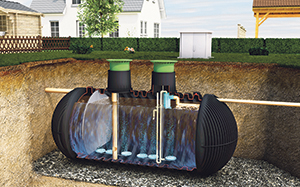Two years ago, Natural England advised a number of local authorities in the Solent catchment area to halt the determination of planning applications unless the developments could prove they were nutrient neutral. And the issue is spreading. David Stagg, technical product specialist for wastewater experts Graf UK, advises housebuilders and developers how to break the deadlock.
Concerns about the effects of nutrient over-enrichment within some European-designated nature conservation areas, including those in the Solent and Poole Harbour, have existed for many years.
However, Natural England has now updated its advice on the complex issue following a judgement by the Court of Justice of the European Union in two joined cases related to the EU Habitats Directive, now known as the Dutch nitrogen case, or even more simply, the Dutch case.
The ruling has meant even greater scrutiny of the water quality of Special Areas of Conservation (SAC) and Special Protection Areas (SPA) across the UK, with the building of residential properties particularly being linked to excess nutrients entering nearby water sources.
High levels of these nutrients, which come directly from wastewater treatment discharges and indirectly from farm drainage/runoff, sewage/silage systems, enter streams and rivers, causing excessive growth of green algae, which smothers rare habitats and wildlife.
While the construction industry largely ignored the advice at the time, thousands of planning applications for tens of thousands of much-needed new homes now remain on hold while housebuilders and developers struggle to find a long-term viable solution. Some local authorities are even dismissing appeals for single dwellings if the schemes cannot be shown to be nutrient neutral.
Morgan Sindall did manage to persuade Hampshire County Council that its Later Living £13 million Addenbrooke extra-care scheme in Gosport could be nutrient neutral with the installation of water-saving flow regulators… but this was at a cost of £50,000.
Another idea is to take farmland out of agricultural production and get developers to turn it into nature reserves against which they could buy credits to offset their nitrate discharge. It’s a slant on carbon neutrality but comes at a cost to them of £1,235 per kilo of nitrogen. And this is not an option for brownfield sites because they will not result in any agricultural land being taken out of production.
However, a long-term viable solution already exists. The development of this technology was implemented more than 15 years ago for Scandinavia, where the phosphate element of nutrient elimination is already common practice.
More than 5,000 wastewater treatment systems with this technology have already been supplied into Scandinavia by Graf to meet these challenging discharge constraints (as with the more challenging nitrate removal in Sweden), which uniquely achieve an independently tested* 0.4mg/l of phosphate removal, only days after commissioning.
Reductions in phosphates as low as 0.2mg/l have even been achieved on a Graf UK installation at the award-winning Scottish attraction Loch Leven’s Larder, a working farm, restaurant, deli, gift shop and playground on the banks of Loch Leven, which attracts more than 300 visitors a day in high season. Renowned for its wintering and breeding wildfowl, the Loch has been designated a SPA by SEPA (the Scottish Environment Protection Agency).
To comply with SEPA’s particularly stringent phosphate and nitrate discharge requirements, the attraction needed to replace its deficient wastewater treatment system with one that limited phosphate discharge to 2mg/l. The new Klaro XXL system is now up and running and is operating to 0.2mg/l (Graf UK’s One2Clean system can also be set up for phosphate removal).
The system can either be supplied as a single-chamber tank featuring a single airlift pumping process, or as a split chamber which utilises multiple airlift pumping processes. The system performance is extremely effective, processing the waste up to a 99% treatment coefficient. The treatment technology can also be combined with precast concrete tanks. Both use sequence batch reactor (SBR) airlift technology, which is widely recognised as being the most efficient for wastewater treatment and results in extremely low volumes of sewage sludge.
The process is wholly controlled in the tank, with precipitants attaching themselves to the phosphate so they sink to the bottom of the chamber for removal by normal desludging.
Another benefit of the more advanced system is it comes with underload detection as standard, which allows it to operate efficiently with up to 75% underload – a benefit particularly for second homes, which are often left unoccupied for long periods of time.
Carbon dosing is an additional option, which can aid nitrate removal by adding a carbon (sugar) solution to the system, which feeds/stimulates the micro-organisms, so they continue to produce high-quality effluent during underload. If the system is likely to drop below the 75% underload threshold the carbon dosing makes up the shortfall to ensure low-odour and even odourless treatment and extended times between tank emptying.
Natural England’s focus on nutrient neutrality is now moving from Hampshire to Herefordshire, Kent, Dorset and Somerset (where there are currently 1,000 developments on hold), forcing some local planning authorities to propose their own, immediate/short-term solutions.
And Natural Resources Wales (NRW) are believed to be taking on nutrient neutrality across the whole country, centred around 11 river regions.
It’s just as well a long-term viable solution knows no borders!
An introduction to SBR systems and nutrient neutrality is available via an online CPD accessed via: https://www.youtube.com/watch?v=GPDx1eoYPH8.
T +44 (0)1608 661500
info@grafuk.co.uk
www.grafuk.co.uk
*PIA GmbH

